Growing up in locker rooms, playing ice hockey and rugby, I learned that games are won less by isolated brilliance than by habits repeated and plays executed seamlessly across the whole team. More recently, after my day job in finance, I spent evenings and weekends coaching youth hockey across all ages and abilities. I began to ask whether my daytime analytics could serve the rink: could we link game statistics to the probability of winning and losing as a function of team effort, not just skill? Could we make the values we preach visible, measurable, and coachable?
From those questions, and the early data, came the Grit Kore lifestyle concept and its practical coaching engine, the Grit Kore Konzept (GKK). The premise is simple: reward the actions that drive the game (heads-up plays, backchecks, forechecks, blocked shots, forced turnovers, assists, and goals), and hold players increasingly accountable for decision quality as they advance. Tally these actions into a single team measure, the Grit Score, and patterns emerge. Over multiple seasons, modest increases in daily effort, on the order of ten to fifteen percent, consistently moved win probabilities by meaningful margins.
The GKK is not a call for perfection, nor a license for punitive metrics, or a guaranteed win. It is a framework for clarity. By naming and tracking the behaviors that matter, we give players a language for improvement, coaches a common standard for feedback, and families a shared understanding of what progress looks like. The goal is not to produce stat sheets for their own sake; it is to cultivate environments where positive communication, accountability, and connected play become the default.
In our following posts you will find the stats, the routines and the reasoning: how to implement GKK with different age groups, how to interpret results, and how to translate numbers into teaching moments that reinforce team identity. We encourage coaches to use this material as a scaffold, adapt it to your context, keep what serves your players, and refine the rest.
The measure exists only to support the mindset, creating one spoken language between all players and coaches, rewarding effort over achievement, creating a synergy leading to growth and success. If these ideas help one athlete discover deeper resilience, one line play more connected, or one team carry its habits beyond the rink, the work has been worthwhile.
How 10–15% More Effort Tilts the Odds
Every team says they want to “work harder.” The Grit Kore Konzept (GKK) gives that cliché a number, and a scoreboard. Over four seasons of running the GKK, the same pattern keeps popping off the page: when a team increases day-to-day effort by 10–15%, the probability of winning jumps by about 50 points (percentage points). Teams that embraced it finished their seasons in their division’s championship games. Effort matters. Measurable effort matters even more.
What the GKK Measures (and Why It’s Simple)
Players earn 1 point each time they execute the habits that drive winning hockey:
-
Heads-up play (make the right pass, keep the puck in the zone)
-
Backcheck
-
Forecheck
-
Blocked shot
-
Forced turnover
-
Assist
-
Goal
At higher levels, players can lose a point for poor decisions and lost possession. That accountability tightens the standard and rewards smart aggression.
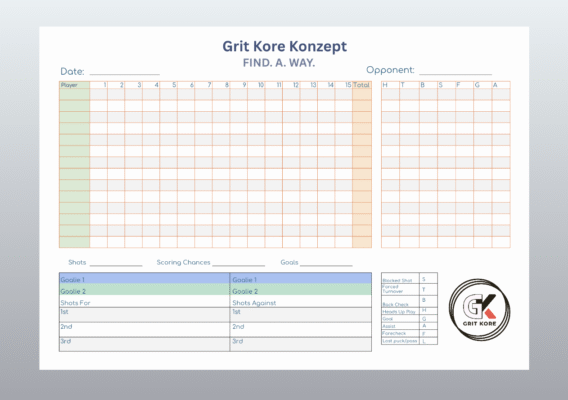
Add up all the player points from a game and you get the Grit Score. That’s it. No complicated formulas, no black-box indexing, just a clean tally of gritty plays.
Why 10–15% Is the Sweet Spot
We analyze each season’s Grit Scores using averages, standard deviations, and cumulative distribution functions for wins and losses. Across multiple teams and seasons, the same signal shows up:
-
+10% effort → ~+50 points in win probability
-
–10% effort → +50–60 points in loss probability
As an assistant coach, this reframes my job. I’m a cheerleader for 10% more, using positive communication and praise to nudge one more stride on the backcheck, one more stick in a lane, one more heads-up play under pressure. Those extra reps compound into real, predictable outcomes.
Context Matters: Rink Size, Age, and Style of Play
A few field notes from applying GKK from Squirt B through Peewee AAA:
-
Higher levels need higher Grit Scores. To consistently give yourself a chance at the top of the ladder, your average team Grit Score often needs to hover around 100. Space changes everything. If NHL players skated on a polo field, there’d be more time and space, fewer defensive engagements, and lower Grit Scores.
-
Small-area hockey is a grit factory. Mites on small surfaces get tons of reps: more turnovers forced, more blocked shots, more forechecks, exactly the stuff GKK rewards.
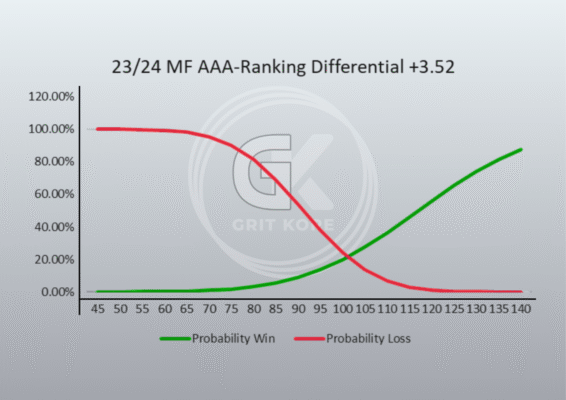
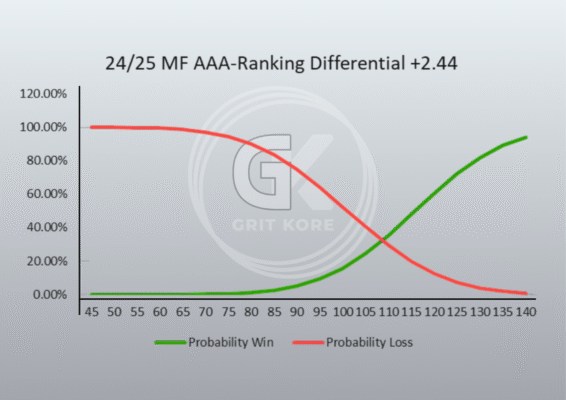
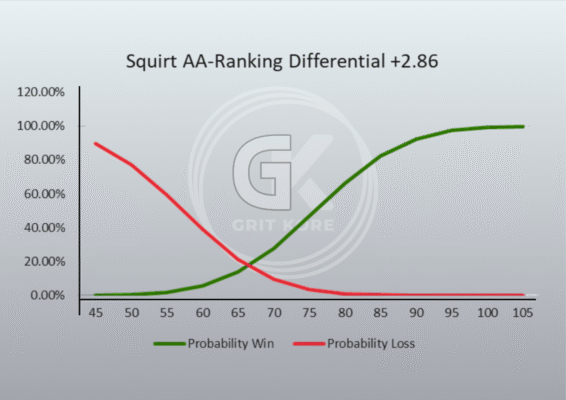
A Live Example
Watching elite peewee hockey this summer, we’ve seen some players struggle with zone entries and the backcheck after failed entries. Many of them dominated full-ice at 7–8 years old on skill alone. As that advantage naturally narrows with age, the game demands an evolution: smarter entries, committed reloads, and layered support. The GKK shines a light on that transition and rewards players who adapt.
This Week’s Results
Two games, two strong Grit Scores, two convincing wins:
-
Team Grit 140 → 24–4 (W)
-
Team Grit 113 → 16–4 (W)
These numbers line up with what we’ve observed at the PW AAA level: when teams cross the 100-ish threshold and sustain it, performance follows. It’s more evidence that positive environments—aimed at creating 10–15% more effort—don’t just build character; they build the right habits to play the game the right way.
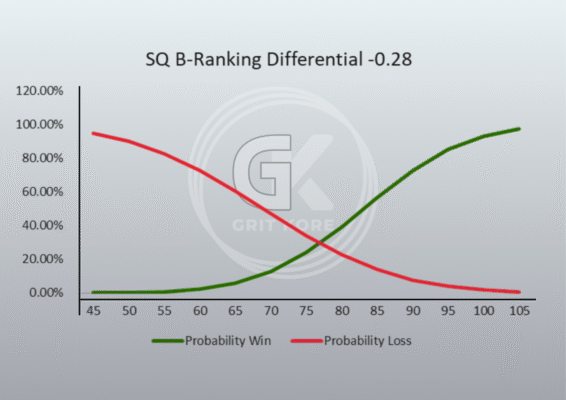

Why It Works (On the Ice and Off)
Through this lens, the GKK is bigger than hockey:
-
It’s clear. Everyone knows what earns a point.
-
It’s contagious. One blocked shot inspires the next line.
-
It’s coachable. Positive feedback loops make the 10–15% bump feel reachable, not mythical.
-
It’s life. If you can summon a little more effort consistently—at school, at home, in training—you tilt the odds of reaching your goals.
That’s why we say hockey emulates life. The GKK isn’t just a stat sheet; it’s a daily discipline to earn grit.
Try the GKK With Your Team
We’re piloting the Kid Gritivity Skills Book with select teams this season, and we’ve created a printable GKK sheet any coach can use right away.
-
Want in, or want the printable? Email greg@gritkore.com.
-
We’ll add you to weekly updates and send the sheet.
-
Share your team’s weekly results with us to help grow the research and sharpen the model.
Give your players a target they can feel, track, and own. Chase 10–15% more each day, and watch the scoreboard catch up.
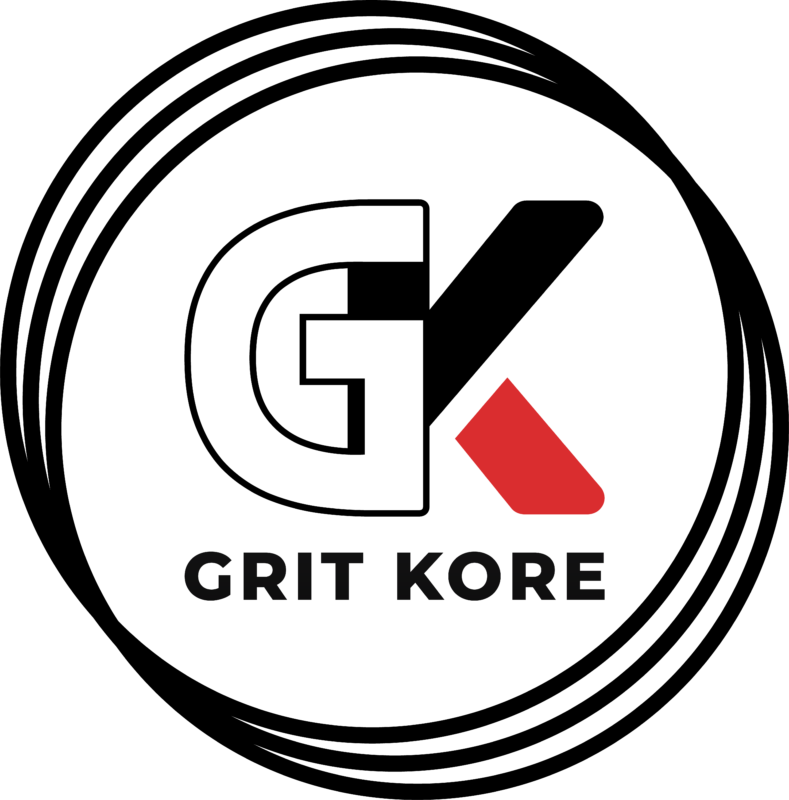
Pingback: Behind the Bench, Beyond the Stats: Building a Grit Hockey Culture - Grit Kore